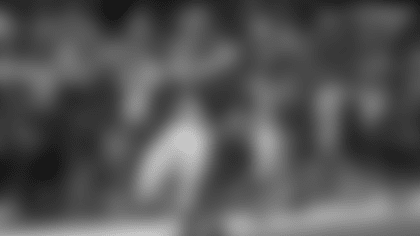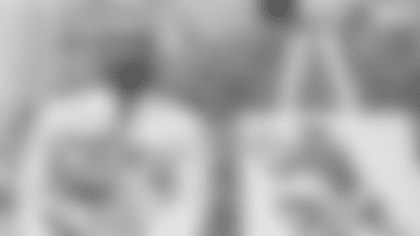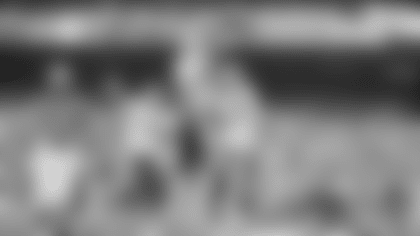In today's Rewarding Moments In Washington History presented by Maryland Lottery My Lottery Rewards, Santana Moss opens up about Washington trading for him and his first season with the team in 2005. (By Zach Selby)
Santana Moss was genuinely caught by surprise when he was informed the New York Jets were going to trade him.
As a matter of fact, thoughts of wanting to play elsewhere were not even on his mind by the time he had finished his fourth season. He had put up 1,943 yards and 15 touchdowns in the past two years, and his agent had already told him his contract was going to be handled.
Then he started hearing the rumblings that he could possibly be playing for another team in 2005. Moss likes to say he "blows as the wind blows me," so he was not upset about the news. He was going to roll with whatever direction the wind took him -- in this case, it was a few hours south to the DMV -- and would be ready to produce.
As it turns out, the winds were working in Moss' favor that day. One year after blowing into Ashburn, Virginia, and joining the Washington Football Team, he was second in the league with 1,483 receiving yards, caught nine touchdowns and was voted to the Pro Bowl. Moss always had this nagging feeling he could be more than what he was with the Jets, and thanks to a fresh opportunity, he was able to prove it.
"When the opportunity is given, man, all you can do is produce," Moss said, "People ask me to this day, 'What is your legacy?' I always say, 'I don't know. I don't get too deep into that. But if you want to write something about me, [I was] the guy that did more with less."
It took some time for Moss to show that he was the dynamic receiver he knew he was. The Jets had a different plan for him when they traded up to pick him 16th overall in 2001; they wanted him to be their return specialist. He was injured for most of his rookie season, but he dominated in his second year by leading the league in punt return touchdowns and averaging 16.5 yards per return.
But despite his 5-foot-10, 193-pound frame, Moss felt like he could be more than a return specialist, and he proved exactly that in his third season with his first-career 1,000-yard season and a career-high 10 touchdowns. On top of leading the team in receiving yards, he was voted a Pro Bowl alternate once again -- this time as a receiver.
At that point, Moss felt he had proven he was a starting-caliber receiver, so he took himself off of special teams and focused all of his time on being a wideout. That frustrated the Jets' coaching staff, Moss said, but there was not a receiver on the Jets' roster who had come close to eclipsing the 1,000-yard mark in at least two seasons, so he felt like he was their best option. The way Moss saw it, why would he spend time as a returner when he could be more effective on offense?
Moss put up solid numbers in his fourth season -- 838 yards and five touchdowns -- despite dealing with a hamstring injury and getting 39 fewer targets, but the Jets ultimately decided to trade him to Washington for Laveranues Coles before the final year of his contract began. Two months after the deal was finalized, Washington signed Moss to a six-year deal.
"I just knew what I was going to bring to the table," Moss said. "I come from a background of teams where...you didn't have to be a team for me to succeed. Just give me the opportunity. And I'm going to go out there and put up numbers."
Washington had a run-heavy offense at the time with Clinton Portis in the backfield, but head coach Joe Gibbs wanted to make sure Moss and tight end Chris Cooley got their touches. Moss had 33 receptions in the first five games -- just 12 fewer than in all of his final season with the Jets -- and put up at least 80 yards in every contest.
Part of that production stemmed from how Washington altered his passing offense once Mark Brunell replaced an injured Patrick Ramsey in the season opener against the Chicago Bears. It got to the point where Moss said the team "started putting stuff in the dirt" to try and exploit defenses.
"It was so creative," Moss said. "I could run every route in the book. So it actually helped us be able to say, 'Ok, well this guy can do it all and we're going to give them a chance to do it.'"
Week after week, it became obvious that Moss was one of Washington's most potent weapons. Four of his first six games ended with a 100-plus receiving yard performance. By the time the team was preparing for the postseason, he was averaging more than 17 yards per reception and had a catch rate of 62.7%.
All the while, thoughts of having to prove himself never crossed Moss' mind. Where some players would have been upset that they were traded, he was actually happy because living in the DMV "felt like home."
"I can't live feeling like I have to show something to you," he said. "I feel like when I add that pressure to myself, it never works out in my favor. So, I've always been a guy to accept what life throws me."
Moss had little trouble catching anything that was thrown at him during his first season with Washington. He set a single-season franchise record for receiving yards and was named a second-team All-Pro for his efforts. It was the start of a successful 10 seasons with the team, as he went on to become the burgundy and gold's fourth-leading all-time receiver behind Gary Clark, Charley Taylor and Art Monk.
Moss is not one to brag about his accomplishments; actions speak louder than words to him, and he always wanted to prove his worth based on how he could help the team. So what did his time in Washington prove? Based on his numbers, talent and lasting impact, it is clear the team was right to take a chance on him.
"I was a guy that was able to do it for a long time," Moss said, "regardless of what level they considered me to be on, because that's why that's how I carry myself. And that's how I appreciated the opportunity that I was given."













